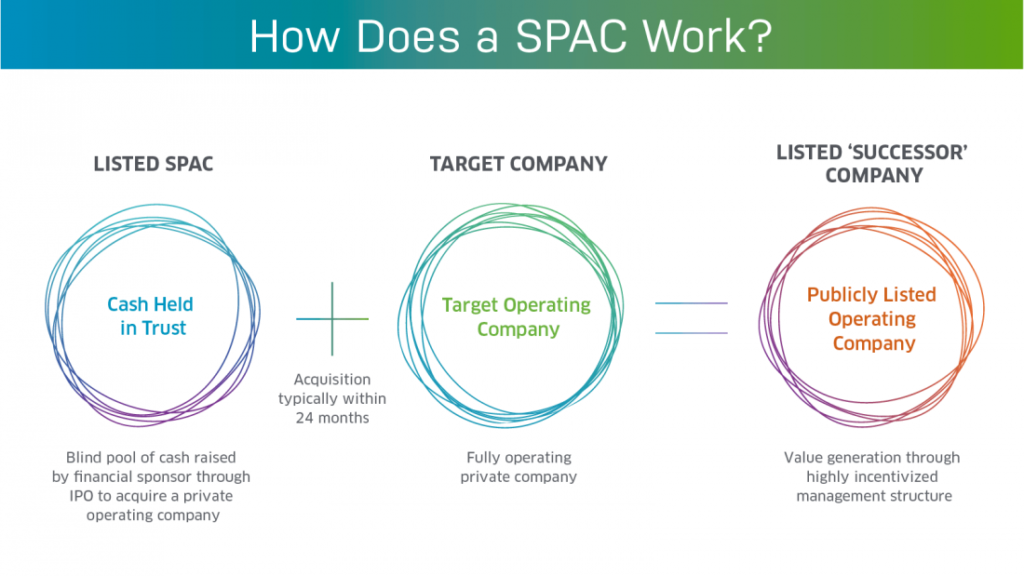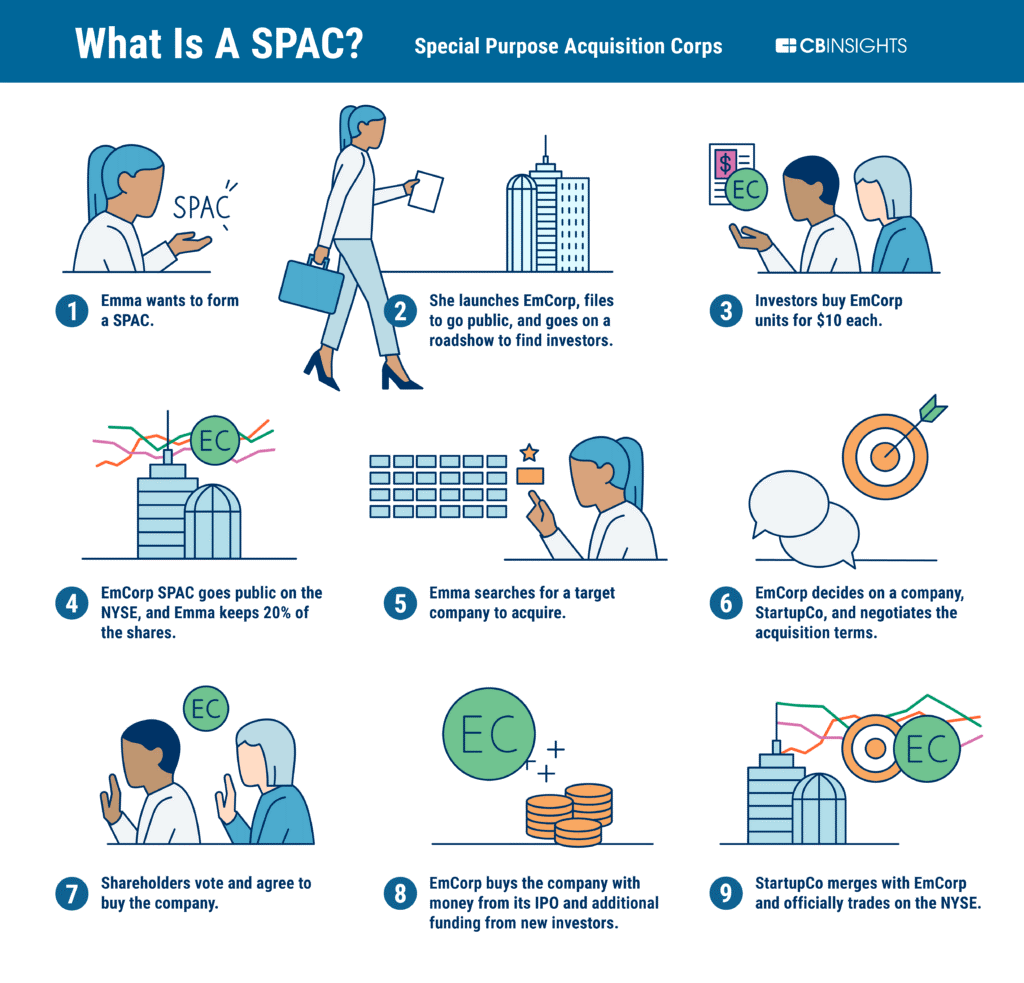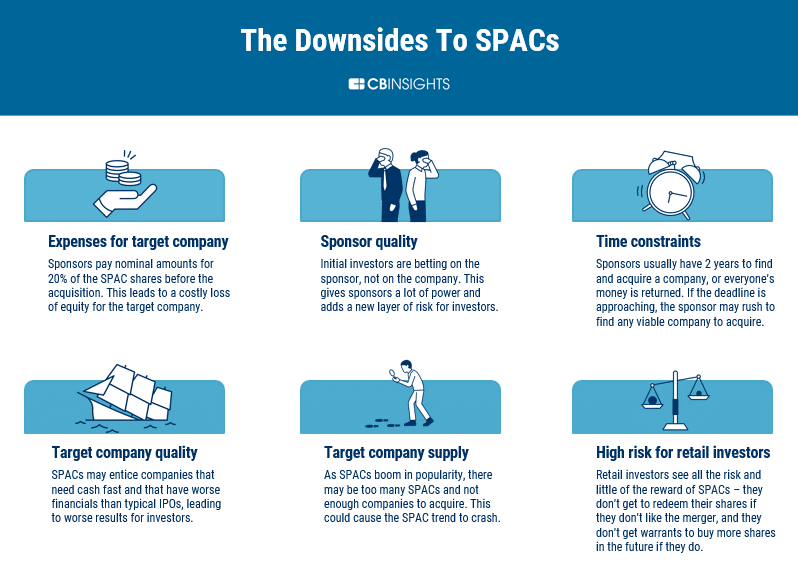Investor Education Series: What is a Special Purpose Acquisition Company (SPAC)?
Special Purpose Acquisition Companies or SPACs for short seems to be the new buzzword in the world of IPO. What exactly is a special purpose acquisition company (SPAC)? How to invest in SPAC?
SPAC is essentially a blank-cheque company whose sole purpose is to bring private companies to the public market.
They are publicly-listed entities but have NO COMMERCIAL OPERATIONS to speak of. Instead, they raise money in an IPO, keep that in an interest-bearing trust account, and then go about trying to reverse-merge with a private company so that their shares will also become public.

The capital is raised through shares and warrants and SPACs typically only have a certain amount of time (typically 2 years) to buy a company or they have to return the capital to shareholders.
However, investors in SPACs have to note that if the SPAC fails to find a suitable private candidate to merge with, it will return investors’ money but only the amount that shares were initially offered at. So, if a SPAC goes public at $10/share and an investor purchased it for $15/share (after all the hype), he/she would lose $5/share of the SPAC if a deal does not happen.
Such a method of “IPO” has become increasingly popular over the past few years. The diagram below from CBInsights summarizes what a SPAC is.

2020 is the year of SPACs
According to SPAC Insider, 2020 is the year of SPACs, with a total amount of US$82.9bn in gross proceeds (as of 29 December 2020) across 248 SPACs. That is way higher than the US$13.6bn gross proceeds raised in 2019 and US$10.8bn gross proceeds raised in 2018.

Some of the more popular companies we know today that went public through the SPAC route are Virgin Galatic, DraftKings, and Nikola Motors.
Let’s use the Virgin Galactic example to understand how this process works. Virgin Galactic was a privately-owned company back in 2019. Then a SPAC company, Social Capital Hedosophia Holdings, agreed to buy 49% of Virgin Galactic for US$800m.
This meant that Virgin Galactic is now owned by a public company. The name of the combined company was changed and the stock ticker altered to SPCE and Social Capital Hedosophia shareholders became Virgin Galactic shareholders.
Investing through SPAC: A simpler listing process
This process might seem complicated at first glance but the SPAC approach can reduce the amount of headache for companies seeking to go public.
Merging with an already-existing public company appears to be a simpler and quicker process than filing to go public independently.
It is also a more low-profile way to go to the market as it doesn’t involve the same roadshows that a traditional IPO entails. A more established company, with strong brand equity, such as Airbnb might, however, choose the more traditional IPO route as it “could be” more lucrative for existing shareholders of the company.
The keyword here is “could be”. The original shareholders of recent high-profile IPOs such as Doordash, Airbnb, etc have lamented that they have left “money on the table” based on the offering price and the price that the stock opens on the exchange.
The disparity between these figures represents either cash the company could have raised itself or additional shares it did not need to sell.
Special Purpose Acquisition Company, SPACs do not need to court additional investors, so they bypass the roadshow process altogether. And because the people leading the SPAC usually have lots of experience taking a company public, the IPO process is relatively simple for a SPAC.
Much like a venture capitalist, or a VC, would do, a SPAC sets out to identify a company that can best benefit from its capital, its founders’ expertise in business and operations, as well as its network of connections: often a private company with a grand vision, a competent team, and breakthrough idea — but little or no revenue.
The SPAC then makes an offer to acquire a stake in the company. If the target company accepts, the merger goes through, and the combined entity changes its name and ticker symbol to better reflect the acquired company’s business.
More SPACs ahead?
Thanks to the success of companies like Virgin Galactic and DraftKings, one should expect the SPAC-based IPOs to continue over the coming months and years.
Bill Ackman, after being spurned by Airbnb, is still on the lookout for a company to snatch up with his Pershing Square Tontine Holdings (PSTH) SPAC. Rampant enthusiasm over possible acquisition targets has ballooned PSTH’s premium over NAV to roughly 25%.
One can however gain “indirect” access to PSTH the cheaper way through his closed-end fund, Pershing Square Holdings (PSHZF), which trades at a 29% discount to NAV. This is, however, not the topic of discussion in today’s article.
Chamath Palihapitiya, the man behind Social Capital Hedosophia Holdings has already launched two more SPACs (IPOB and IPOC) with the express intention of finding businesses “operating in the technology industries”.
IPOB for example has merged with Opendoor and began trading on Dec 21, 2020, closing at a high of US$31.25.
IPOC is expected to merge with Clover Health Investments Corp, with the combined entity expected to begin trading on Nasdaq on Jan 8, 2021, under the new ticker symbol “CLOV”.
The next high-profile SPAC to be listed in 2021 will be Softbank’s SPAC called SVF Investment Corp which will seek to raise as much as US$605m in its IPO next year. The new SPAC will try to merge with a company in a “technology-enabled sector” and there is a possibility of linking up with one of the private companies already backed by SoftBank’s $100bn Vision Fund.
Hopefully, it is not going to be WeWork.
A key risk for investors in SPACs
One of the most common criticisms leveled towards SPACs is that the people bringing these private companies public are not as invested in the long-term success of the company as they might seem and it is perceived as an easy way for these wealthy sponsors to further enrich themselves.
As it currently stands, SPAC sponsors pay about $25,000 to receive 20% of the SPAC shares, assuming a deal is completed. For example, if a SPAC raised $500m initially, the sponsor pays $25,000 and gets $100m in shares once the merger occurs.
Not only does this mean that essentially a fifth of the company is given away almost immediately, but there is also a risk that the SPAC sponsor has no real incentive to find a quality business and will instead go for an easier, sub-prime option of selecting any companies available to reap big returns in the short-term.
In our example, even if the new company’s stock drops by 50%, the sponsor still makes nearly $50m.
The easy nature of going public this way is the main reason for many choosing to do so and this in itself is a sign of a frothy market, filled with uncertainty.

What to look out for in a new SPAC
While there is risk involved in investing in a new SPAC, not all SPACs are “scams” in the making.
There are a few key things one should look out for when vesting in SPACs.
- Management Team
Having a good management team behind the scenes is very important with an investment in a SPAC. As there are no actual business operations to speak of, you are trusting this team to make the best possible acquisition with your money. A SPAC run by a savvy dealmaker with a good track record should be your No.1 consideration.
- Compensation of sponsor
To assuage any concerns that the management team of the SPAC is out to make a quick buck, it is also good to see their interests aligned with shareholders. Look out for sponsors that are willing to invest their own money into the newly-formed companies they are creating, or even ones that are passing up on the typical 20% cut altogether.
Bill Ackman’s Pershing Square Tontine is forfeiting the 20% founder shares and claims that his hedge fund, Pershing Capital would invest $1bn of its capital to complete the merger.
- Acquisition Strategy
All SPACs will include details of the types of companies they wish to target in their IPO prospectus. While they are not always completely beholden to these guidelines, they will give you an indication of the types of companies they are interested in acquiring.
Are SPACs right for you?
An early investor in Social Capital Hedosophia Holdings Corp (IPOA), the SPAC that merged with Virgin Galactic, would have grown his/her investment over 10x faster than investing in the S&P 500.
So a SPAC can be seen as a way for the man-in-the-street to get in early, like at the initial offering price of an IPO. The key difference is that unlike in a traditional IPO which you probably know (or assume you know) what you are vested in, purchasing a SPAC before any announcement of an acquisition/merger is like shooting in the dark. You do not know what you are getting into.
Investors are putting their trust in the reputation, track record, and expertise of the SPACs founders as well as their ability to spot successful companies.
It is like investing alongside a venture capitalist.
How to invest in SPACs
Buying SPACs is just like buying stocks. They all have tickers and are traded on exchanges such as NYSE.
For a full list of SPACs, one can refer to SPAC Insider.
Most of the SPACs will likely be trading at around US$10/share intrinsic value until an announcement is made. That is when the “pop” in share price will happen.
For SPACs which are nearing their 2-year “deadline, there might be a risk that no deal will happen. In such a scenario, the capital will be returned to shareholders. Hence there is no downside (beyond opportunity cost) if you can purchase a SPAC at US$10/share.
One way to further limit your risk would be to use options to invest in these “speculative plays”. Take, for example, if I wish to partake in Social Capital Hedosophia Holdings Corp 4th SPAC (IPOD), with 3 already announced deals (IPOA, IPOB, IPOC), I might want to limit my risk capital by purchasing a call option on IPOD, which is currently trading at US$12.30/share.
My maximum risk is the premium I pay for the counter. However, if history is to repeat itself, shares of IPOD could appreciate more than US$20/share. IPOA, now Virgin Galactic (SPCE), is trading at US$23.75. IPOB, now Opendoor (OPEN) is trading at US$25/share. IPOC, soon to be CLOV, is trading at US$16.24/share.
The upside on my IPOD call option, if a positive acquisition announcement is made, could then be significant.
If one wishes to purchases a basket of recent SPAC offerings, the Defiance Next Gen SPAC ETF (SPAK) allows one to do it.
Conclusion
SPAC stocks can go up pre-acquisition, with SPAC Insider reporting annualized rates of returns or ARRs as high as 1,508% (Bridgetown Holdings Limited, sponsored by Peter Thiel and Richard Li), with an average ARR of 49.6%.
The table below shows the Top 10 SPACs’ (seeking a target) ARR

Does it make sense to be buying up these “shell” companies, driving their share prices significantly higher even before an announced acquisition?
The current price appreciation of some of these SPACs which are trading substantially above their NAV pre-acquisition/announcement seems to be on the back of bullish sentiments coupled with the track record of the team behind the SPAC.
Just like VCs invest in a variety of companies, hoping to hit that one “homerun” individuals should probably not put much of their hard-earned dollars in just one SPAC and should only part with capital that they can afford to lose.
There will probably come a time in 2021 where there are too many SPACs chasing too few valid acquisitions. This could cause the SPAC trend to crash.
Do Like Me on Facebook if you enjoy reading the various investment and personal finance articles at New Academy of Finance. I do post interesting articles on FB from time to time which might not be covered here in this website.
Join our Telegram broadcast: https://t.me/gemcomm
SEE OUR OTHER WRITE-UPS
- 17 US COMPANIES MOST AT RISK FROM ESCALATING US-CHINA TENSIONS
- 8 OUTPERFORMING STOCKS TO BUY NOW (PART 2)
- 8 OUTPERFORMING STOCKS TO BUY NOW (PART 1)
- 4 RECESSION-RESISTANT STOCKS WITH A FORTRESS BALANCE SHEET
- 4 STOCKS WITH MORE THAN 80% RECURRING REVENUE OWNED BY GURUS
- A LIST OF “BEST” DIVIDEND GROWTH STOCKS
Disclosure: The accuracy of the material found in this article cannot be guaranteed. Past performance is not an assurance of future results. This article is not to be construed as a recommendation to Buy or Sell any shares or derivative products and is solely for reference only.









